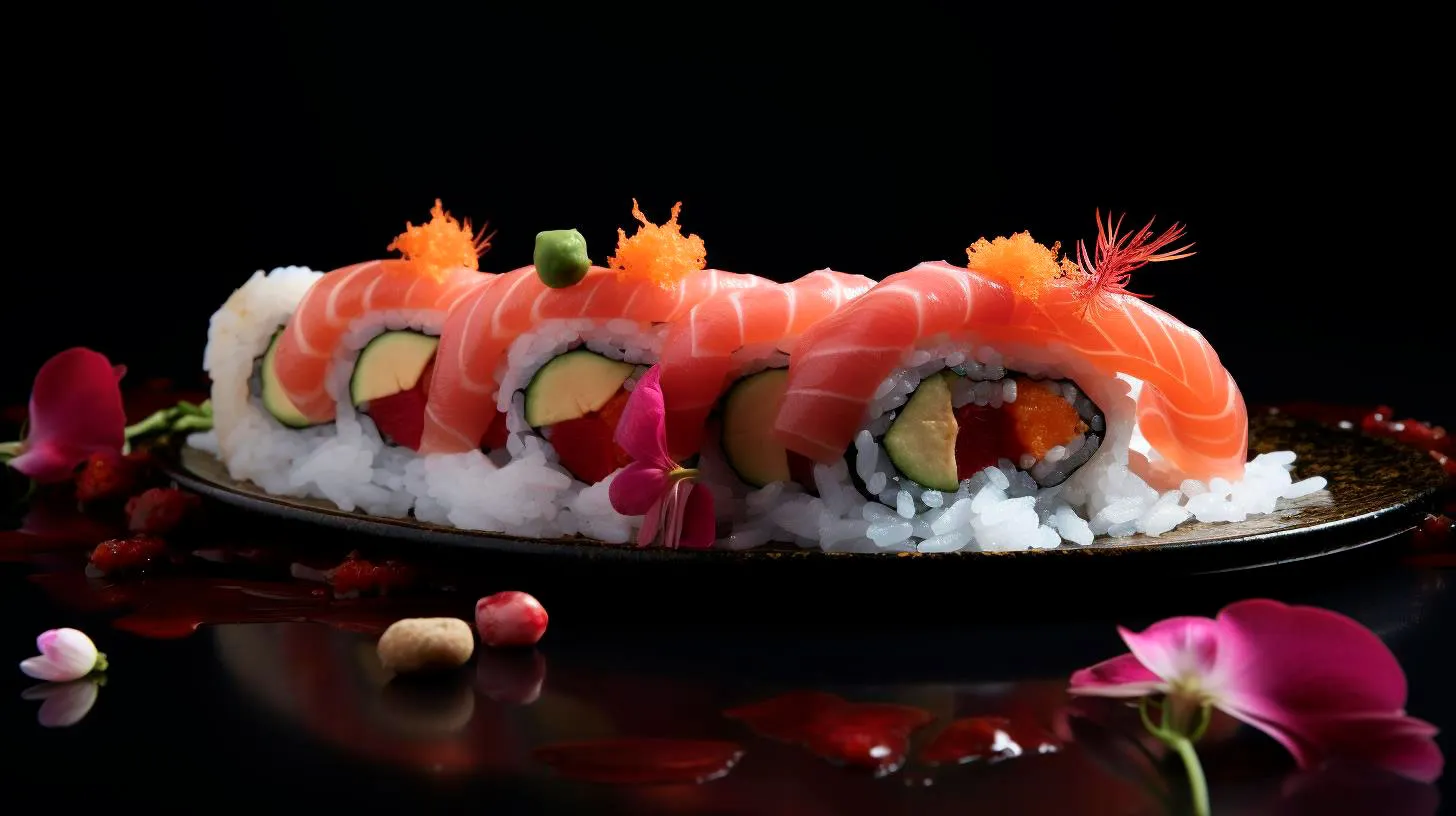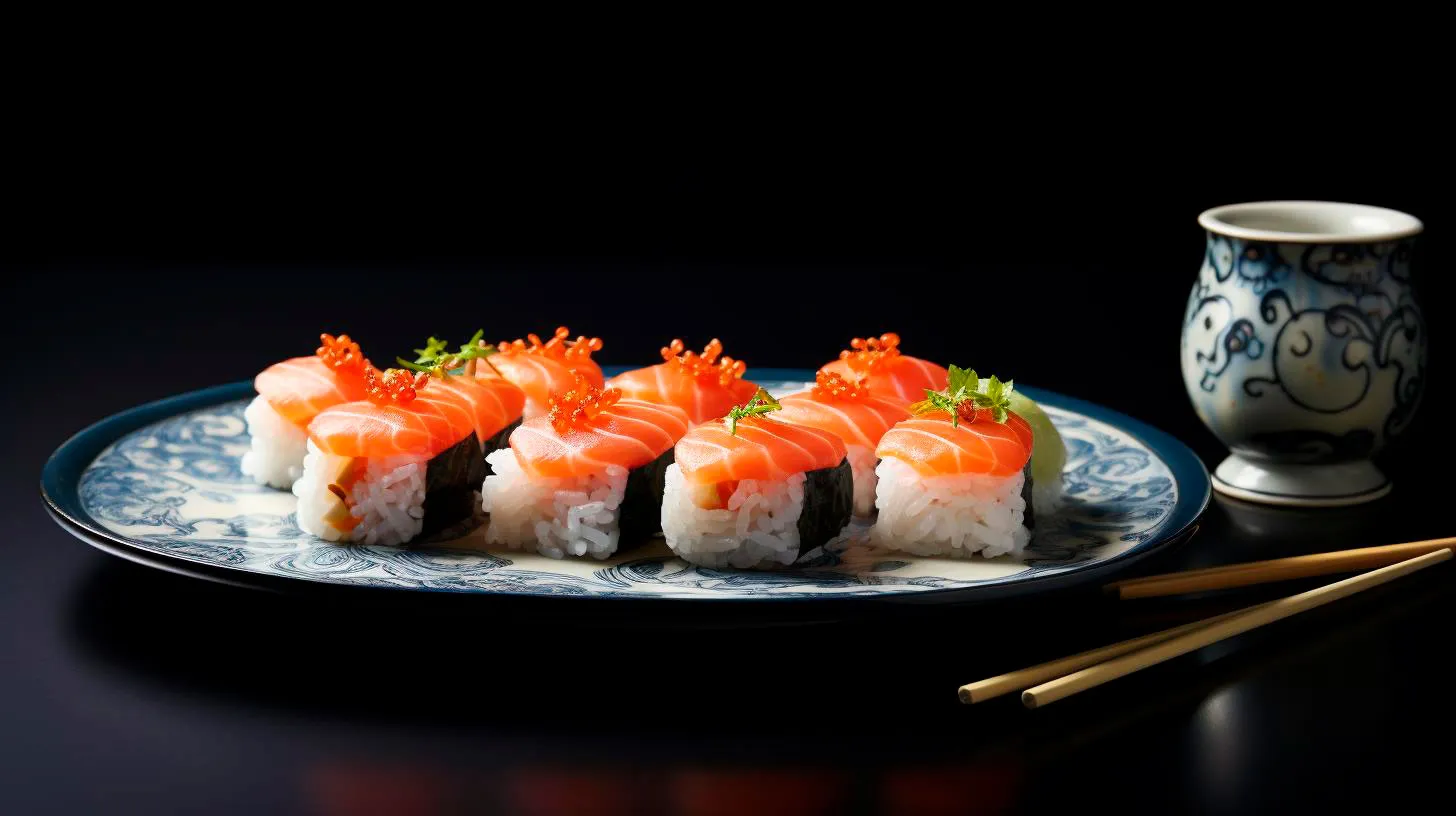Mastering the Art of Sushi: An In-depth Look at the Fish Selection Process
In this article, we delve into the intricate process of choosing the best fish for sushi, providing you with valuable insights into the world of sushi preparation.
The Importance of Freshness
When it comes to sushi, freshness is paramount. The quality and flavor of the fish rely heavily on its freshness, making it crucial for sushi chefs to select the finest cuts available. But what factors determine the freshness of fish? Let’s take a closer look:
- Appearance: Fresh fish should have bright, clear eyes, shiny and intact scales, and vibrant colors that vary depending on the type of fish. Dull eyes, discolored flesh, or a strong fishy odor are signs of poor quality.
- Texture: The flesh of fresh fish should be firm, moist, and springy to the touch. It should bounce back when pressed lightly.
- Smell: A fresh fish should have a mild, oceanic scent. Avoid any fish with a pungent or ammonia-like odor.
Remember, the freshness of the fish directly impacts the taste and overall quality of your sushi. To ensure the best experience, choose reputable sushi restaurants that prioritize sourcing the freshest ingredients.
Sustainability and Responsible Sourcing
Aside from freshness, another important factor to consider in the fish selection process is sustainability. As the demand for sushi rises, it is crucial to ensure that the fish we consume is sourced responsibly to protect our marine ecosystems. Some key aspects of sustainable fish sourcing include:
- Certifications: Look for sushi establishments that source fish from sustainable fisheries and have certifications such as the Marine Stewardship Council (MSC) or the Aquaculture Stewardship Council (ASC), indicating responsible fishing practices.
- Seasonality: Be aware of the seasons in which different fish species are abundant. Choosing fish that are in their peak season helps promote sustainable fishing practices and allows populations to replenish.
- Locally Sourced: Opting for locally sourced fish not only reduces carbon emissions associated with long-distance transportation but also supports local fishermen and their communities.
By supporting sustainable fish sourcing practices, we can enjoy sushi guilt-free and contribute to the conservation of our oceans for future generations.
Popular Sushi Fish Varieties
Sushi offers a wide array of fish varieties, each with its own unique taste and texture. Here are some popular types of fish commonly used in sushi preparations:
1. Tuna (Maguro)
Tuna is a staple of sushi and comes in several varieties, including the leaner akami and the fattier chutoro and otoro. It has a meaty texture and a rich, buttery flavor.
2. Salmon (Sake)
Salmon is highly versatile and widely loved for its distinct flavor and buttery texture. It can be enjoyed both raw and cooked.
3. Yellowtail (Hamachi)
Yellowtail is a prized fish in sushi due to its delicate, melt-in-your-mouth texture and its mild flavor.
4. Snapper (Tai)
Snapper is a firm fish with a mild, slightly sweet flavor. It is often used as a sashimi topping due to its clean taste.
5. Shrimp (Ebi)
Shrimp is a popular sushi ingredient and can be enjoyed raw or cooked. It has a firm texture and a sweet, delicate flavor.
These are just a few examples of the numerous fish varieties that can be found in sushi. Each fish brings its own unique taste profile to the dish, allowing sushi lovers to experiment with different flavors and textures.
Key Takeaways
- Choosing the freshest fish is essential for creating delicious sushi.
- Fish should have clear eyes, shiny scales, firm texture, and a mild scent.
- Always opt for sustainable and responsibly sourced fish.
- Look for certifications and support local fisheries.
- Popular sushi fish varieties include tuna, salmon, yellowtail, snapper, and shrimp.
Mastering the art of sushi requires not only practice and technique but also an understanding of the fish selection process. With this knowledge, you can appreciate the skill and dedication that goes into creating the perfect sushi experience.
Trusting Your Senses: The Key to Enjoying Perfect Sushi
It all comes down to trusting your senses and understanding the key elements that make for an exceptional sushi experience.
The Art of Sushi Making
Sushi is not just a meal; it’s an art form, meticulously crafted by skilled chefs who have honed their craft for years. A beautiful sushi piece is like a small masterpiece that combines taste, texture, and visual appeal. Understanding the basics of sushi making can enhance your appreciation for the art and elevate your dining experience.
Here are essential factors to consider when indulging in the world of sushi:
- Freshness: Fresh fish is the backbone of exceptional sushi. Every bite should melt in your mouth, with the fish tasting buttery and delicate. Sushi chefs pay close attention to sourcing their seafood from reputable suppliers and ensure it is handled with care.
- Rice: Sushi rice plays a critical role in the overall experience. It needs to be properly seasoned with rice vinegar, salt, and sugar, achieving the perfect balance of flavors. The rice should stick together enough to hold its shape but not be too dense or overpowering.
- Knife Skills: The technique and precision of sushi chefs are exceptional. Their knife skills enable them to cut the fish with utmost precision, controlling the thickness and size of each slice. This attention to detail not only affects the flavor but also enhances the aesthetics of the sushi.
- Sauces and Condiments: While sushi is mainly about the fish and rice, the sauces and condiments play a supporting role. Wasabi, soy sauce, and pickled ginger add subtle flavors that complement the fish without overpowering it.
Engage Your Senses
Trusting your senses is crucial when it comes to sushi appreciation. To truly savor the flavors and textures, you need to engage all your senses:
- Look: Take a moment to appreciate the presentation. Notice the colors, shapes, and arrangements of the sushi pieces. Aesthetically pleasing sushi adds to the overall experience.
- Smell: Inhale the aromas before taking your first bite. Fresh fish should have a clean and slightly sweet scent. If anything smells fishy or unpleasant, it may indicate poor quality.
- Touch: Gently touch the sushi with your fingertips. The rice should be slightly warm and stick together without being mushy. Fresh fish should feel firm, yet tender.
- Taste: This is where the magic happens. Take a bite and let the flavors dance on your taste buds. Appreciate the delicate balance between the rice, fish, and any accompanying sauces. High-quality fish should be buttery, with a hint of umami.
- Hear: While not directly related to taste, the ambiance of a sushi restaurant can enhance your experience. Listen to the sounds of chefs diligently working and the conversations around you. It creates an immersive environment that adds to your overall enjoyment.
Benefits of Trusting Your Senses
Trusting your senses is not only about enjoying an exceptional sushi meal; it also offers several benefits:
- You can detect the freshness of the fish, ensuring you have a safe and hygienic dining experience.
- You become more discerning and can differentiate between exceptional sushi and subpar versions.
- Trusting your senses allows you to appreciate the craftsmanship and artistry behind each sushi piece.
- Engaging your senses enhances your overall dining experience, making it more enjoyable and memorable.
The Takeaway
Next time you indulge in a sushi feast, remember that trusting your senses is the key to enjoying perfect sushi. By understanding the art of sushi making and engaging your senses, you can elevate your dining experience. From the freshness of the fish to the delicate balance of flavors, each piece of sushi tells a story. Embrace the art, savor the flavors, and enjoy every bite like a true sushi connoisseur.
From Ocean to Plate: Exploring the Journey of Sushi Fish and Ensuring Quality
Join us on this exploration as we dive into the depths of the sushi fish industry and uncover the secrets behind its freshness and taste.
The Sourcing Process: Bringing the Best of the Ocean
The journey of sushi fish begins with the sourcing process, where fishermen venture into the vast ocean to catch the finest seafood. They employ various techniques like longline fishing, net fishing, or using fishing boats equipped with modern technology to ensure a successful catch. The abundance of sushi fish varieties like tuna, salmon, yellowtail, and many others makes it essential to focus on sustainability and responsible fishing practices.
Key Takeaway: Responsible sourcing and sustainable fishing practices ensure the preservation of sushi fish species and the oceans’ delicate ecosystem.
Transportation: The Race Against Time
Once caught, sushi fish need to be transported quickly to maintain their freshness and flavor. The transportation process plays a vital role in preserving the quality, as any delay can lead to spoilage or loss of taste. Modern refrigerated trucks and air freight systems equipped with temperature control mechanisms help maintain the ideal conditions during transportation, ensuring that the sushi fish reaches its destination in perfect condition.
Statistics: According to industry data, the global seafood transportation market is expected to grow at a CAGR of 5.3% from 2021 to 2026.
Processing and Quality Control: The Art of Perfection
Once the sushi fish reaches the processing facility, it undergoes a meticulous process to maintain its quality and taste. Skilled professionals with years of experience carefully inspect the fish, ensuring it meets the highest standards. The fish is then expertly filleted and sliced to perfection, ready to be used in sushi preparations.
Advantage: Stringent quality control measures ensure that sushi fish served at top-notch sushi restaurants meets the expectations of discerning customers, resulting in a remarkable dining experience.
Certifications: Ensuring Trust and Quality
In the sushi fish industry, certifications play a crucial role in building trust and ensuring quality. Organizations like the Marine Stewardship Council (MSC) and the Aquaculture Stewardship Council (ASC) work closely with fisheries, providing them with guidelines on sustainable and responsible practices. Certifications from such renowned organizations provide consumers with the assurance that the sushi fish they consume aligns with the industry’s best practices.
Key Takeaway: Look for sushi fish with certifications like MSC and ASC to support sustainable fishing practices and enjoy seafood with a clear conscience.
Storage and Distribution: Keeping it Fresh
Proper storage and efficient distribution are essential to maintain the freshness and flavor of sushi fish. Sushi fish is typically stored in temperature-controlled facilities, ensuring that it remains at the optimal temperature until it reaches the sushi restaurant or market. A well-established distribution network helps deliver sushi fish to various outlets efficiently, ensuring that consumers can enjoy their favorite sushi dishes whenever they desire.
Advantage: A well-maintained storage and distribution system guarantees that sushi fish retains its freshness and quality, allowing restaurants and markets to meet the demands of sushi enthusiasts.
In conclusion, the journey of sushi fish from the ocean to your plate involves various intricate processes that ensure its freshness, taste, and quality. Responsible sourcing, efficient transportation, meticulous processing, and adherence to certifications are all essential components to guarantee an exceptional sushi dining experience. So, the next time you savor a piece of sushi, remember the efforts and dedication behind every bite!
Sushi Fish Selection: How to Choose the Freshest Catch
In this article, we will explore the key factors to consider when selecting sushi fish and provide you with valuable tips to ensure you enjoy the best sushi possible.
Why Freshness Matters
Freshness plays a vital role in the taste and safety of sushi. Here’s why it matters:
- Delicious Taste: Fresh fish has a clean and sweet flavor, which enhances the overall taste of the sushi. It offers a delicate and pleasant experience for your palate.
- Safe Consumption: Fresh fish ensures that you are not exposed to potential health risks associated with consuming spoiled fish. By choosing fresh fish, you can have peace of mind knowing that your sushi is safe to eat.
- Texture: Fresh fish possesses firm and tender flesh, creating a delightful texture when combined with sushi rice. It adds an extra layer of pleasure to each bite.
Key Factors to Consider
When selecting sushi fish, keep the following factors in mind:
1. Smell
The fish should have a mild, clean, and slightly oceanic smell. Avoid fish with a strong, unpleasant odor, as it indicates poor freshness. Fresh fish should not have any funky or ammonia-like smells.
2. Appearance
Check for the following visual cues:
- Color: Look for vibrant and shiny fish. Different species have specific colors, but the flesh should generally be translucent and moist.
- Eyes: Clear, glossy eyes are a sign of freshness. Cloudy or dull eyes may indicate the fish is past its prime.
- Gills: The gills should be bright red or pink, indicating that the fish is fresh.
- Scales: If the fish still has its scales, they should be intact and shiny.
3. Texture
The texture of the flesh is a crucial indicator of freshness. It should feel firm, elastic, and moist to the touch. Avoid fish that feels mushy or slimy.
4. Source and Sustainability
Choose sushi fish from reputable suppliers who prioritize sustainable fishing practices. Check if the fish has been responsibly sourced to support ethical fishing and protect aquatic ecosystems for future generations.
Advantages of Choosing Fresh Fish
Opting for the freshest catch offers numerous benefits:
- Enhanced Flavor: Fresh fish provides a more pronounced and enjoyable taste, amplifying your sushi experience.
- Improved Nutritional Value: Fresh fish contains higher levels of beneficial nutrients such as Omega-3 fatty acids.
- Reduced Health Risks: Fresh fish reduces the chances of food-related illnesses caused by consuming spoiled or contaminated fish.
- Elevated Dining Experience: The quality of sushi heavily relies on the freshness of the fish. Choosing fresh fish ensures a memorable dining experience every time.
Key Takeaways
Choosing the freshest fish for your sushi is crucial to enjoying the best taste and quality. Remember these key takeaways:
- Always consider the smell, appearance, and texture of the fish.
- Opt for fish with vibrant colors, clear eyes, and bright red or pink gills.
- Prioritize sustainable sourcing to protect the environment.
- Enjoy the advantages of fresh fish, including improved flavor, nutrition, and safety.
With these insights, you can confidently navigate sushi menus, select the freshest catch, and delight in an exceptional sushi experience. Bon appétit!



